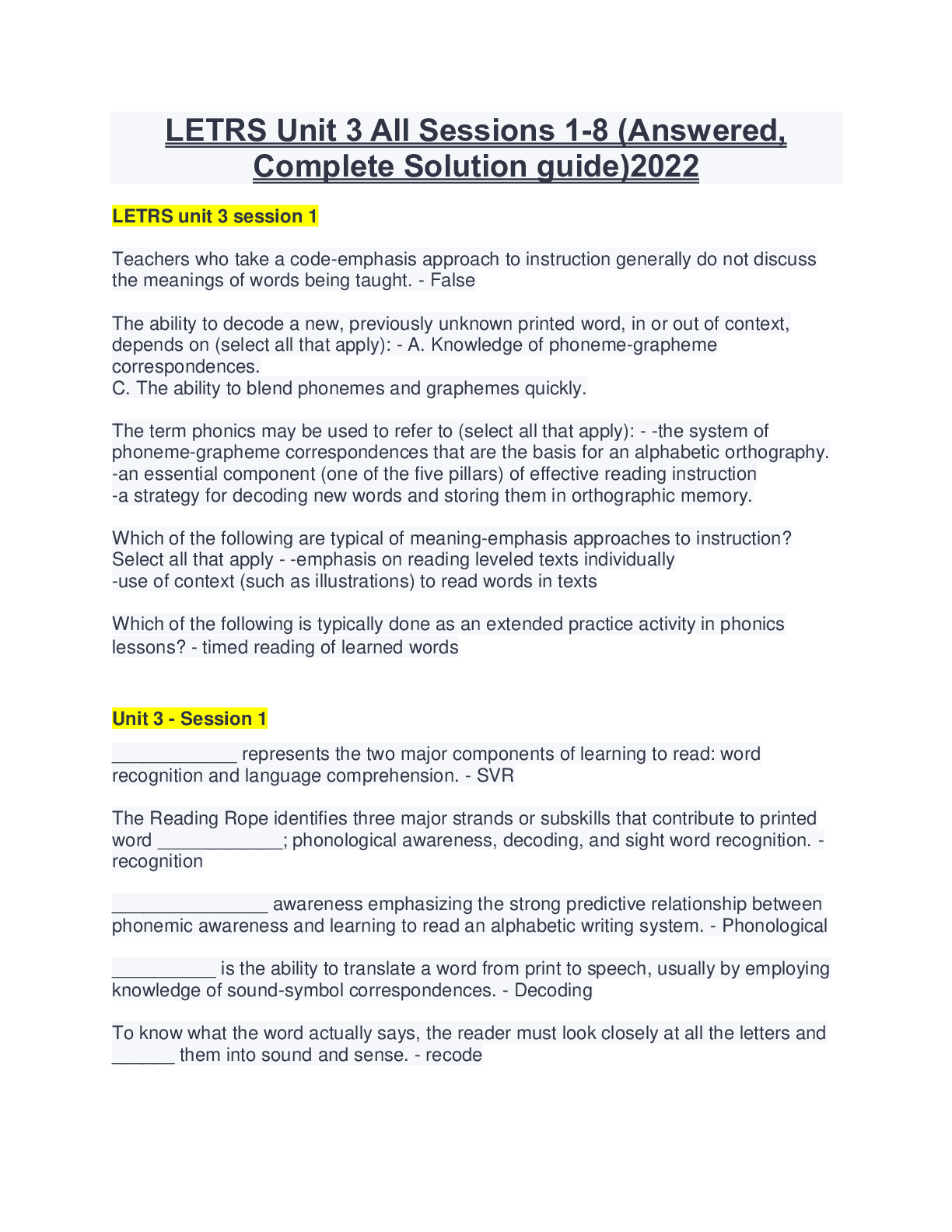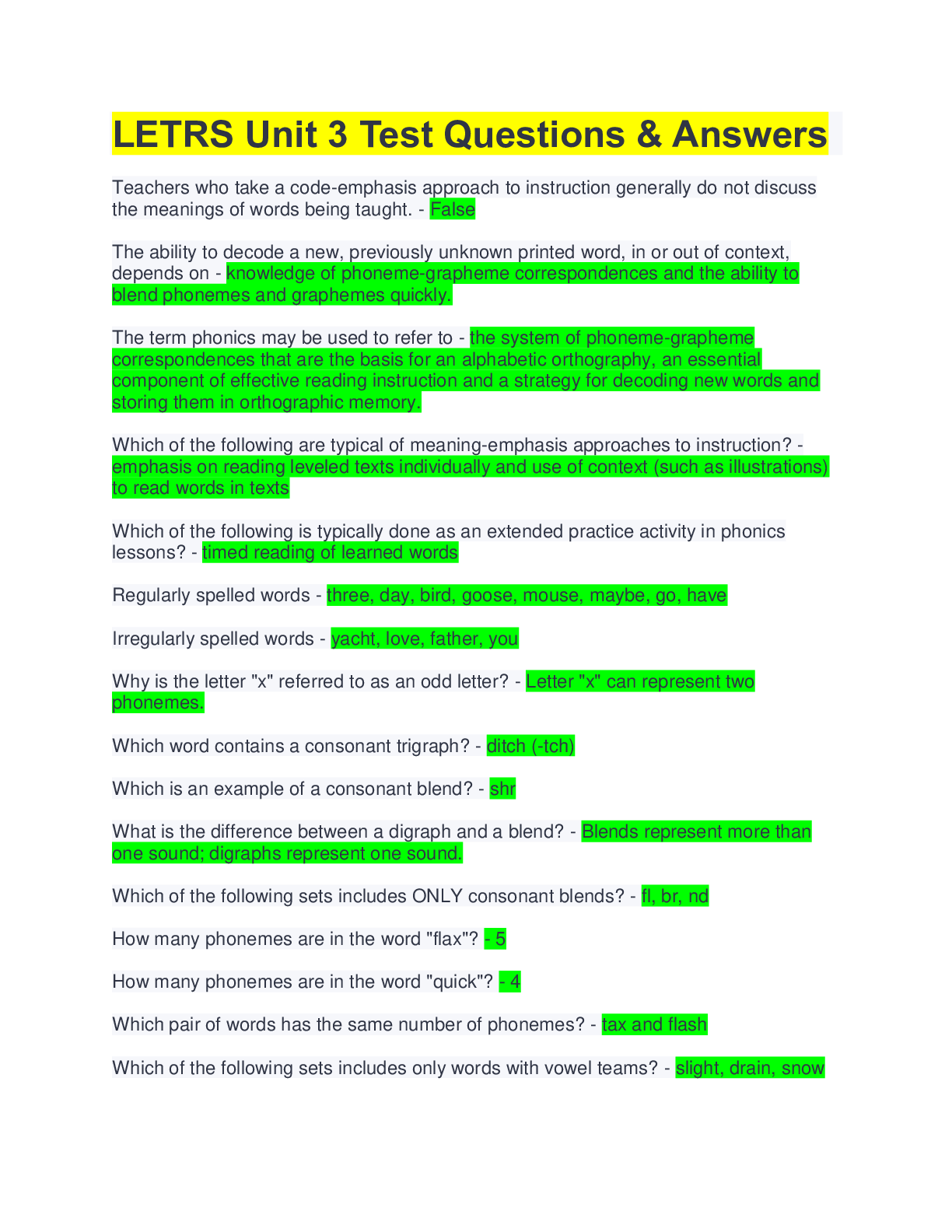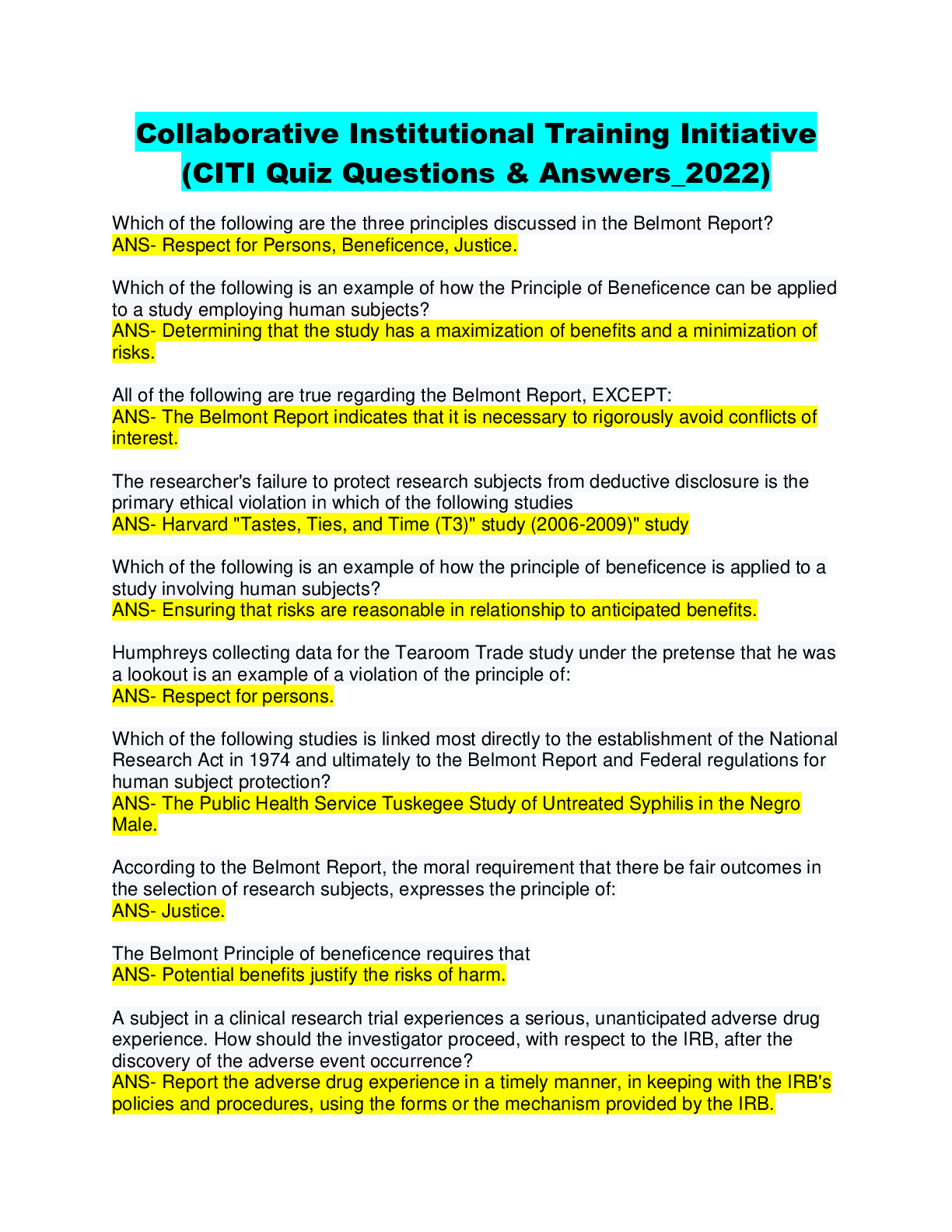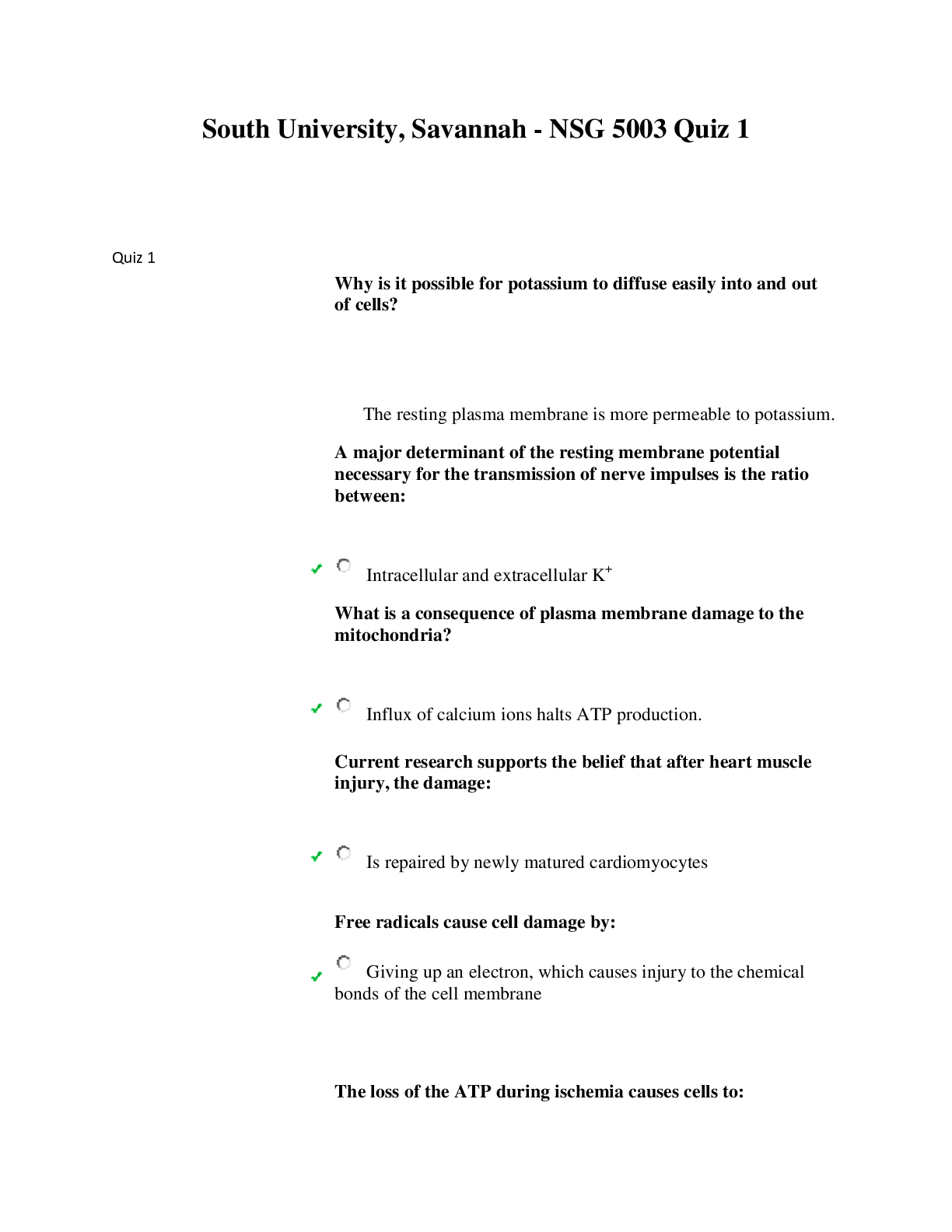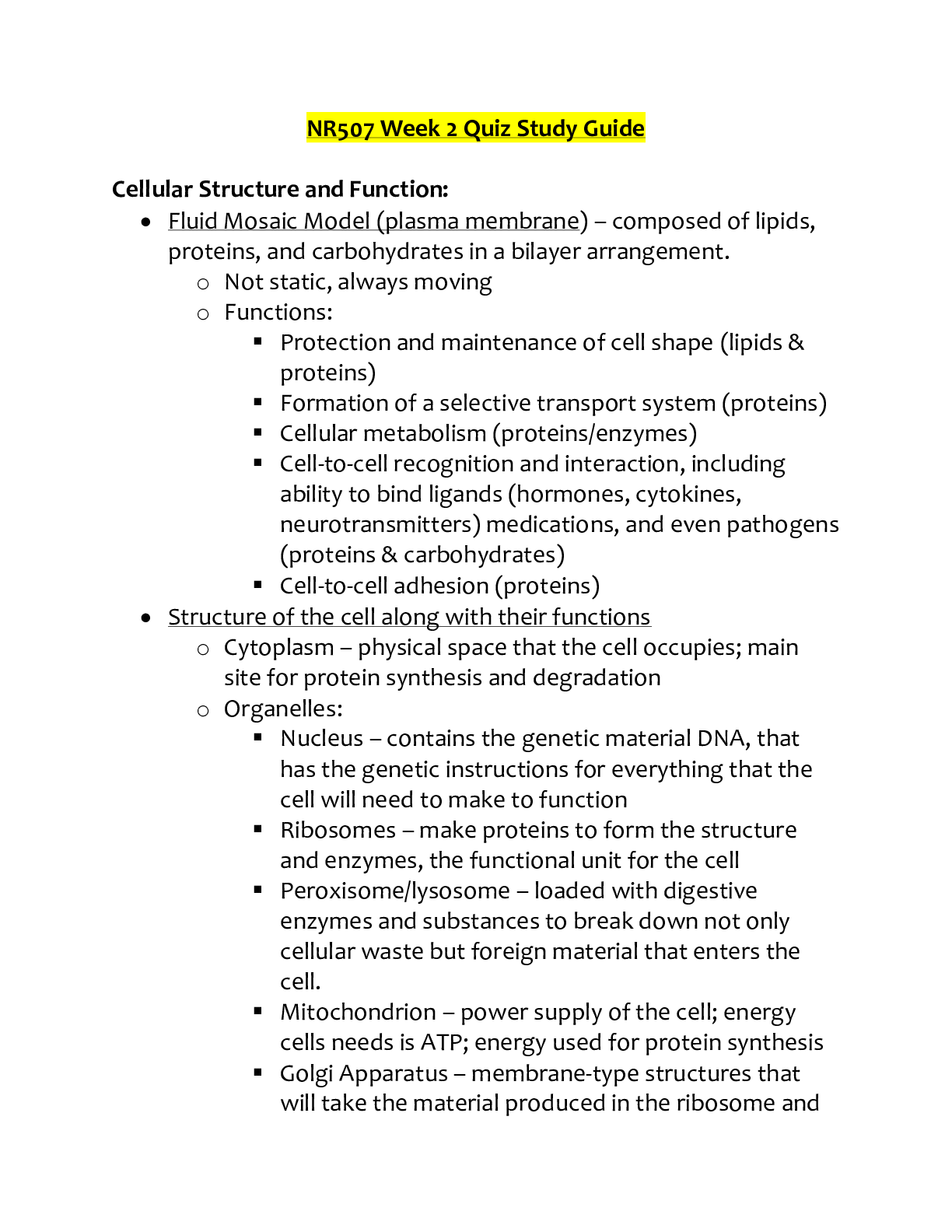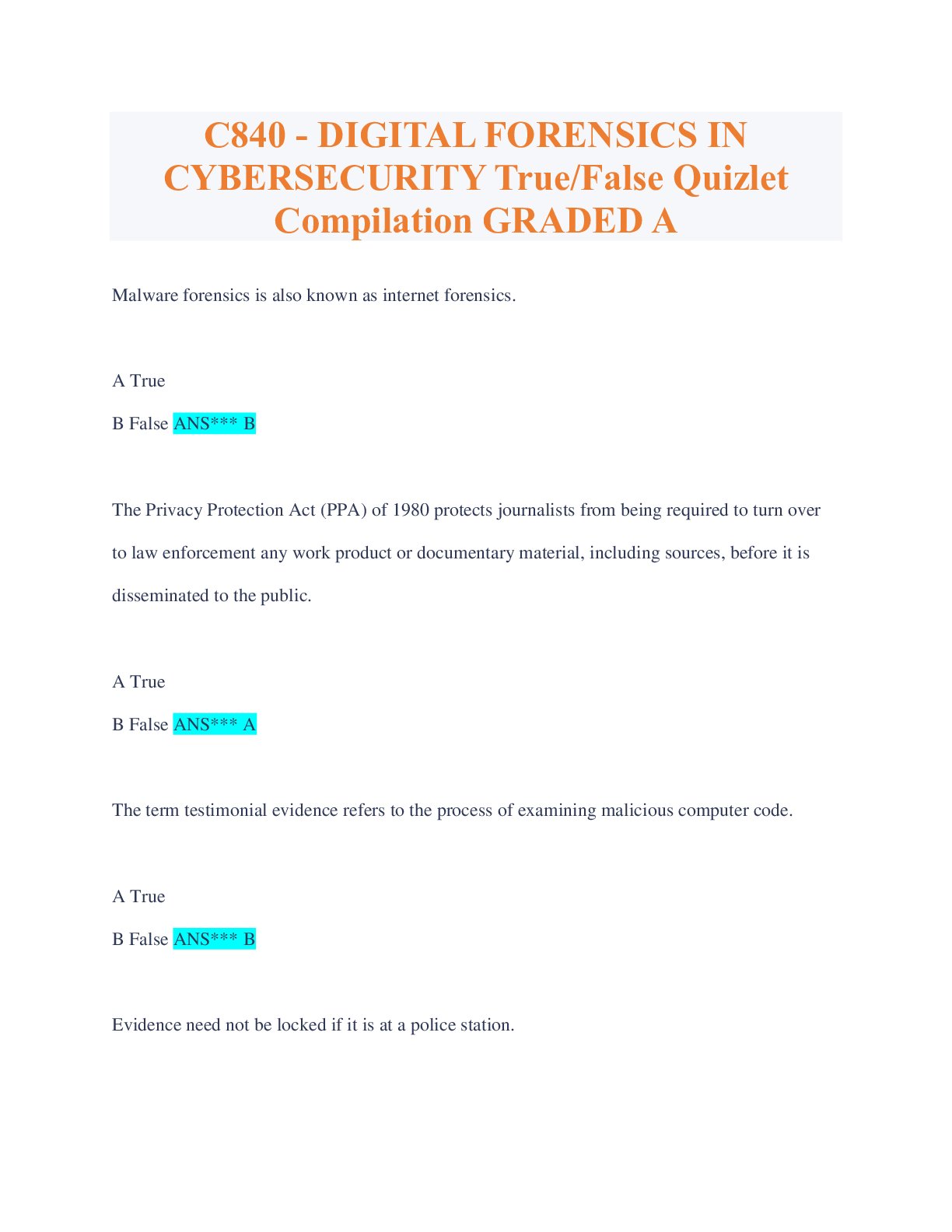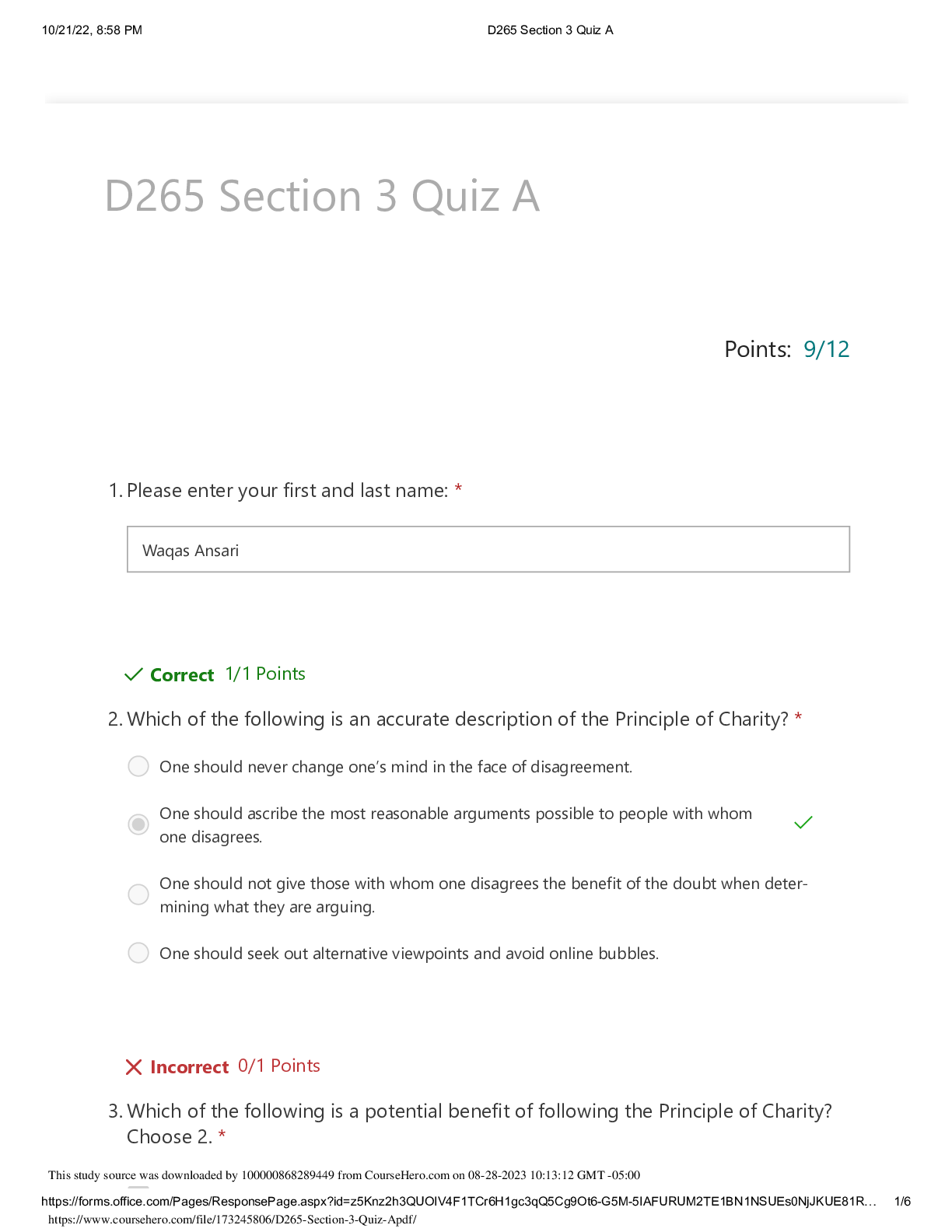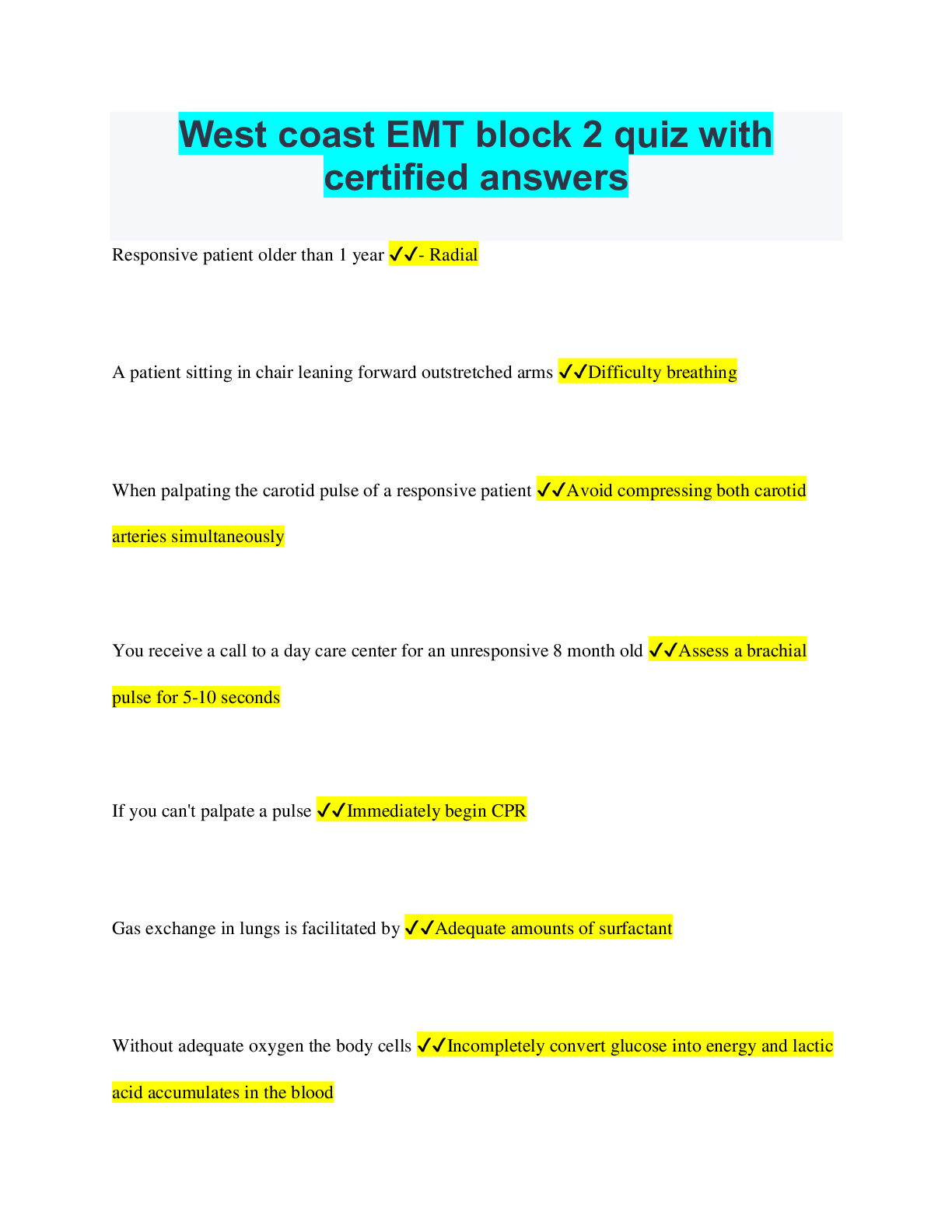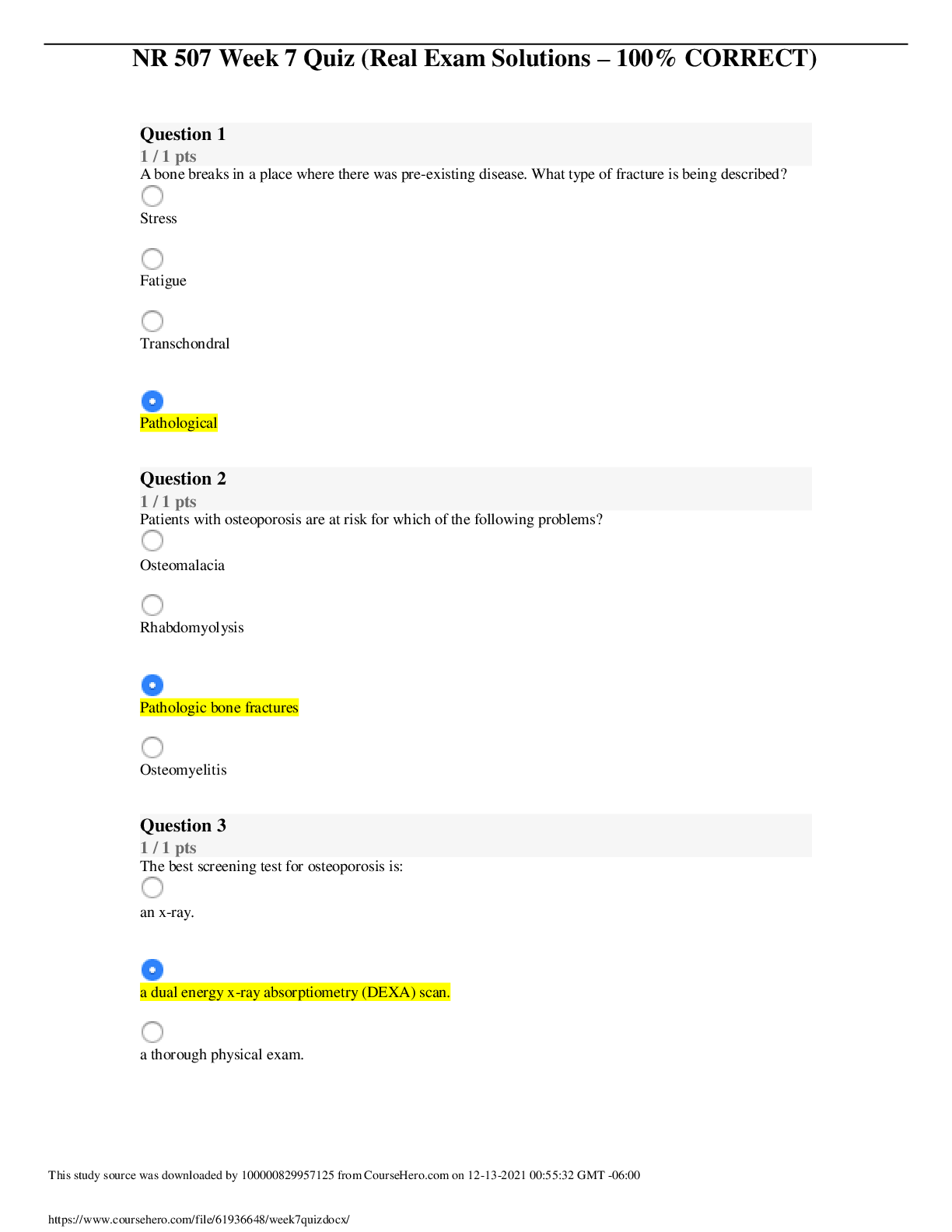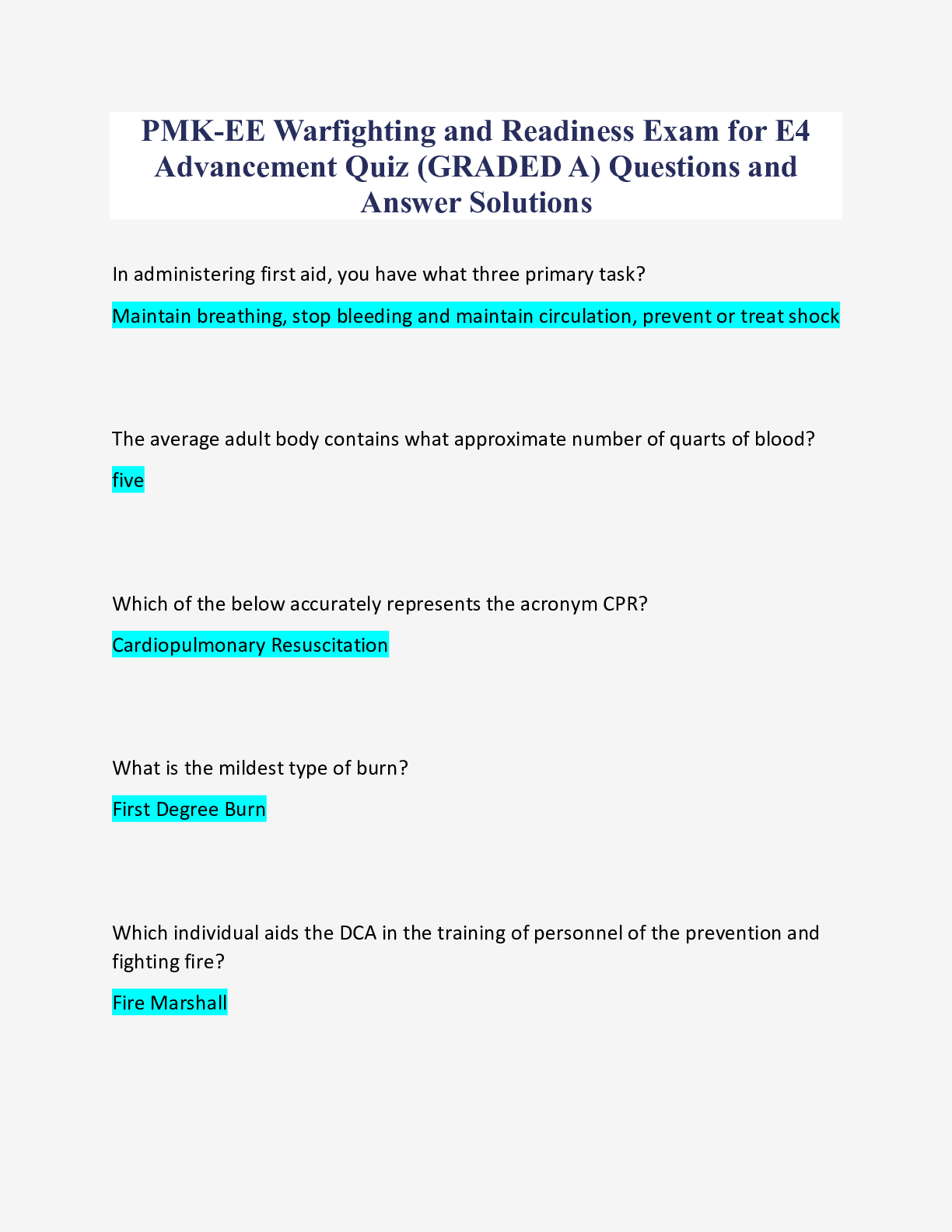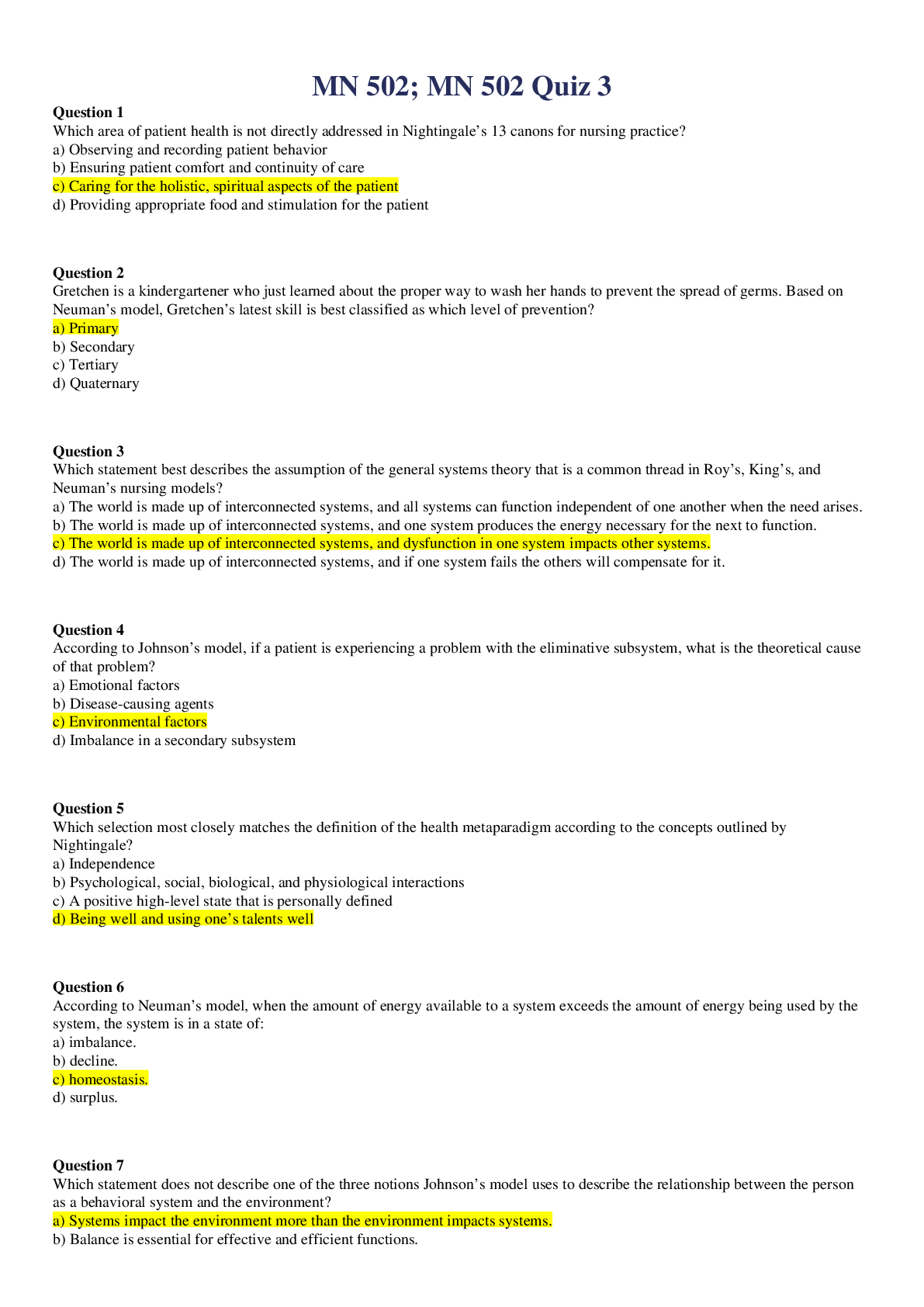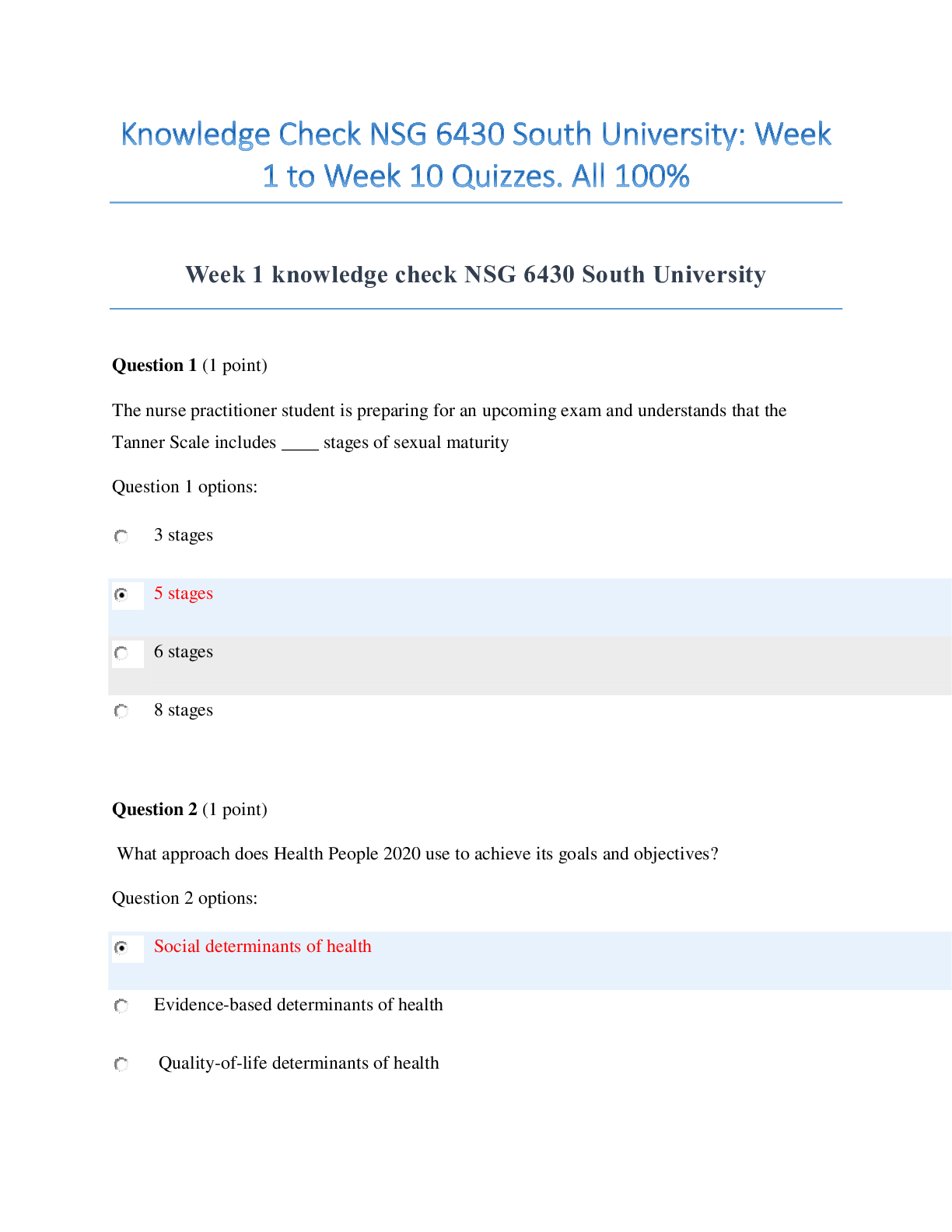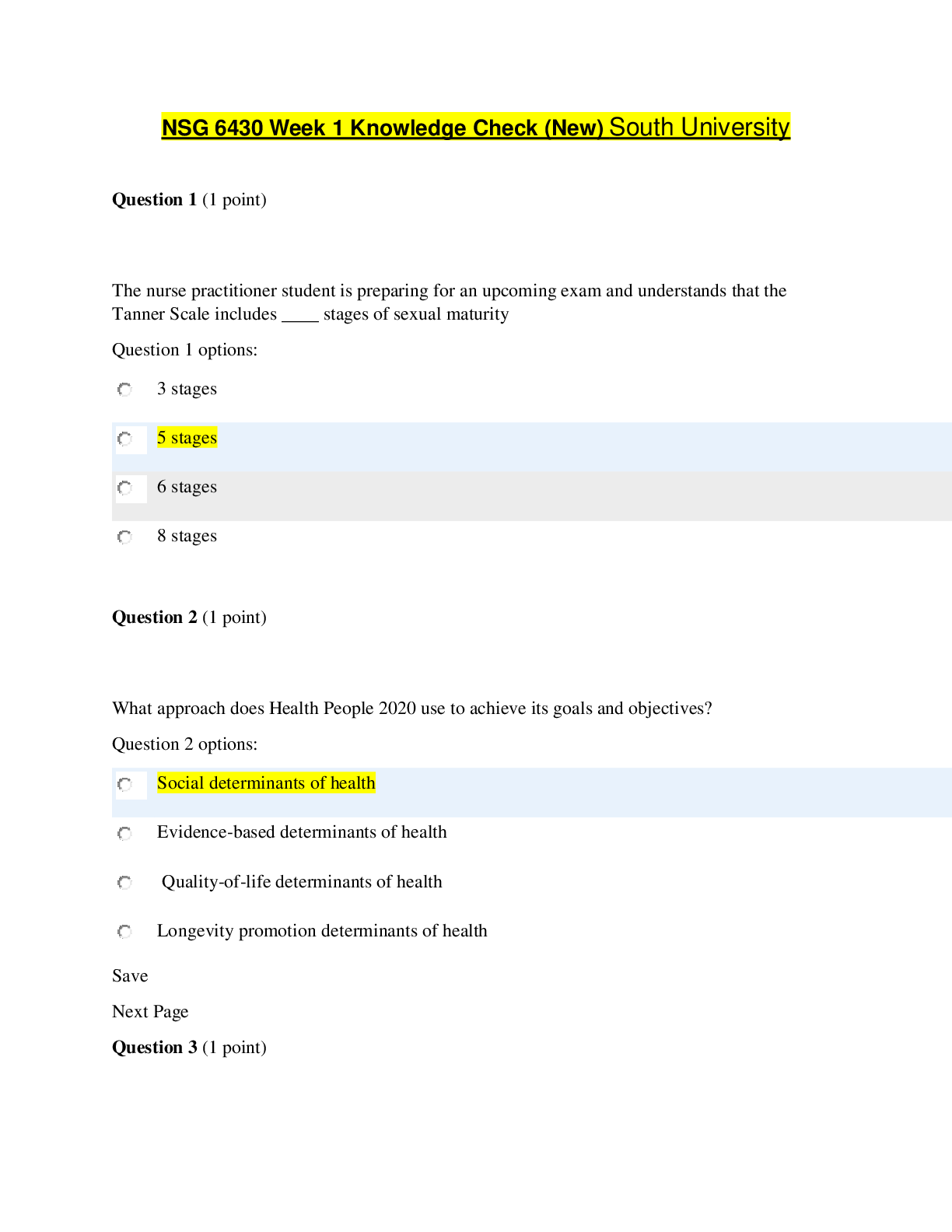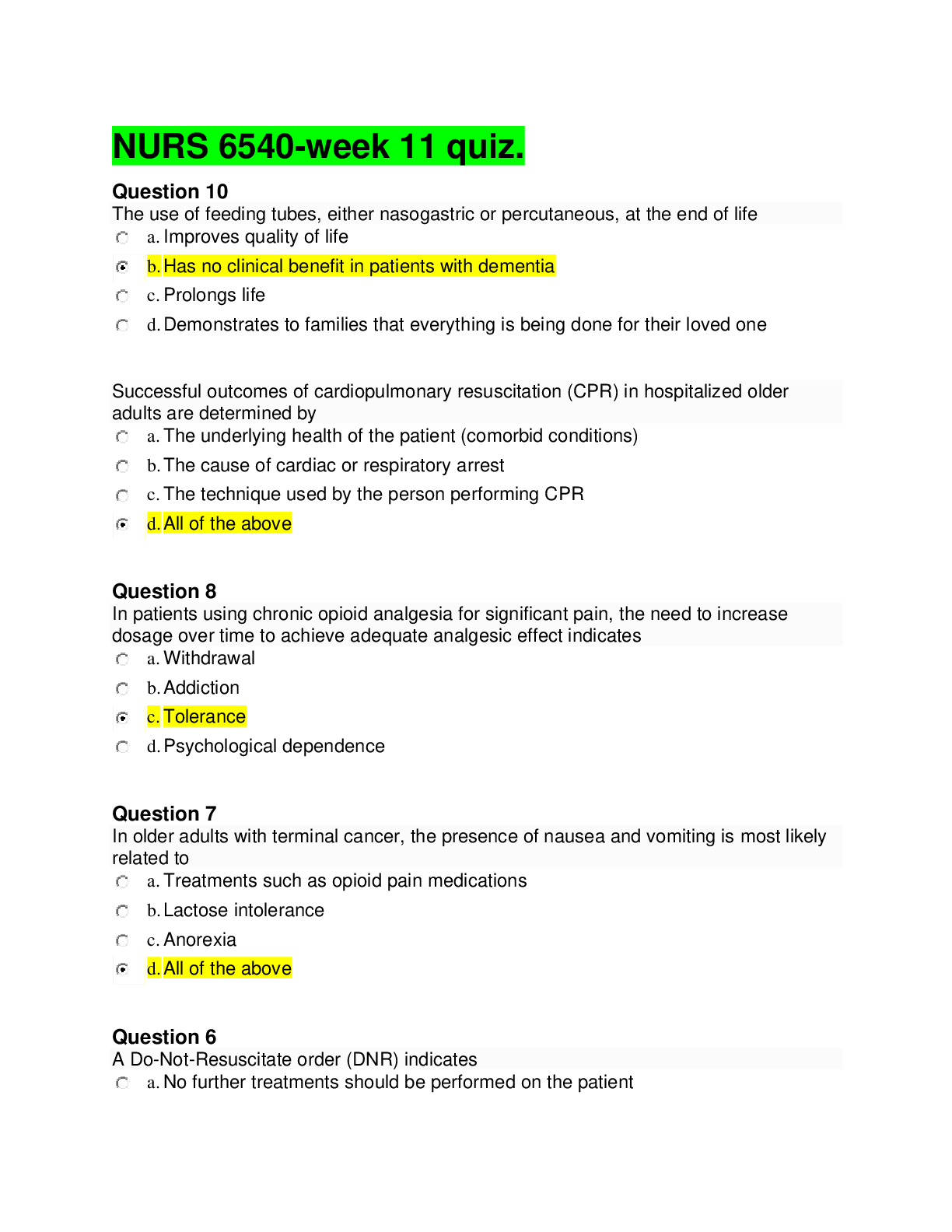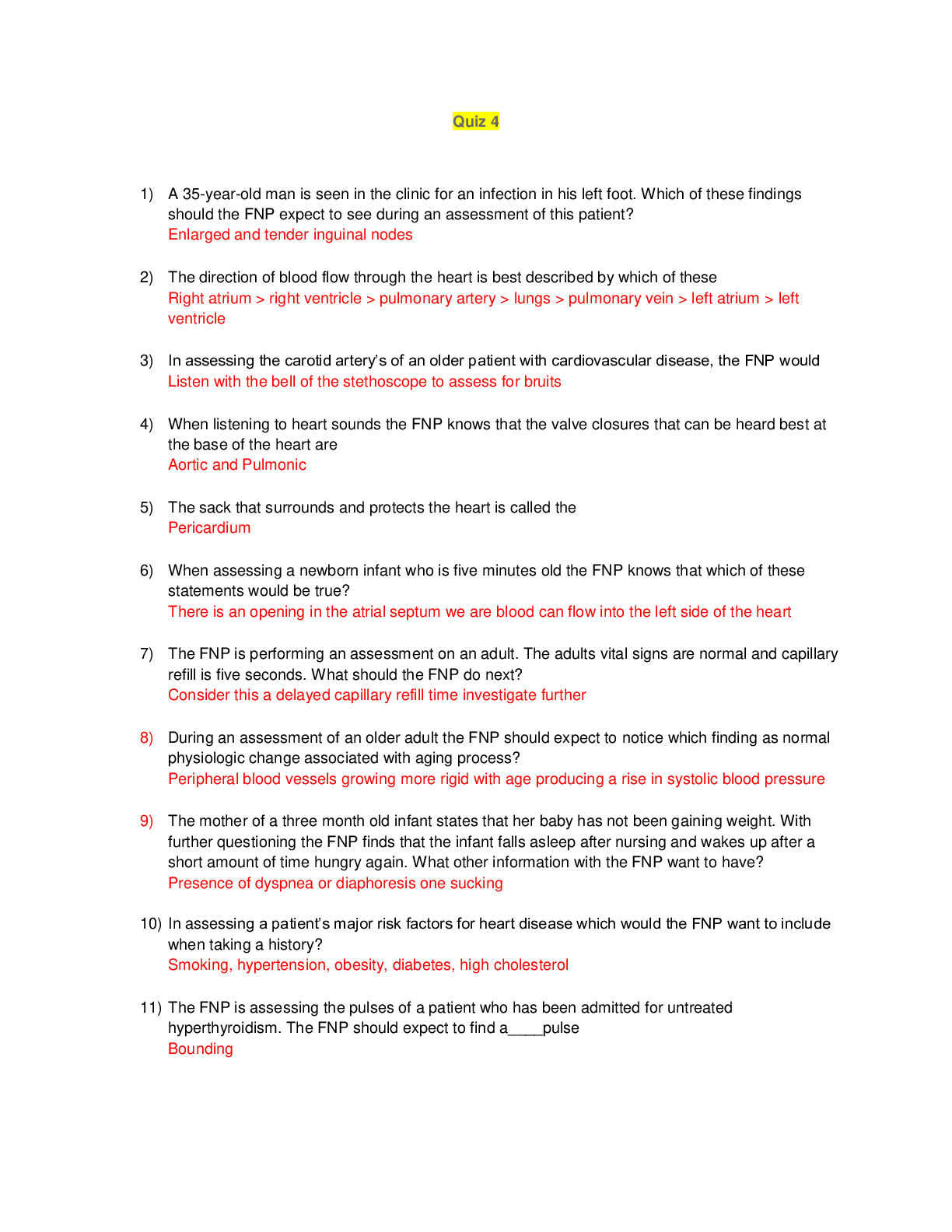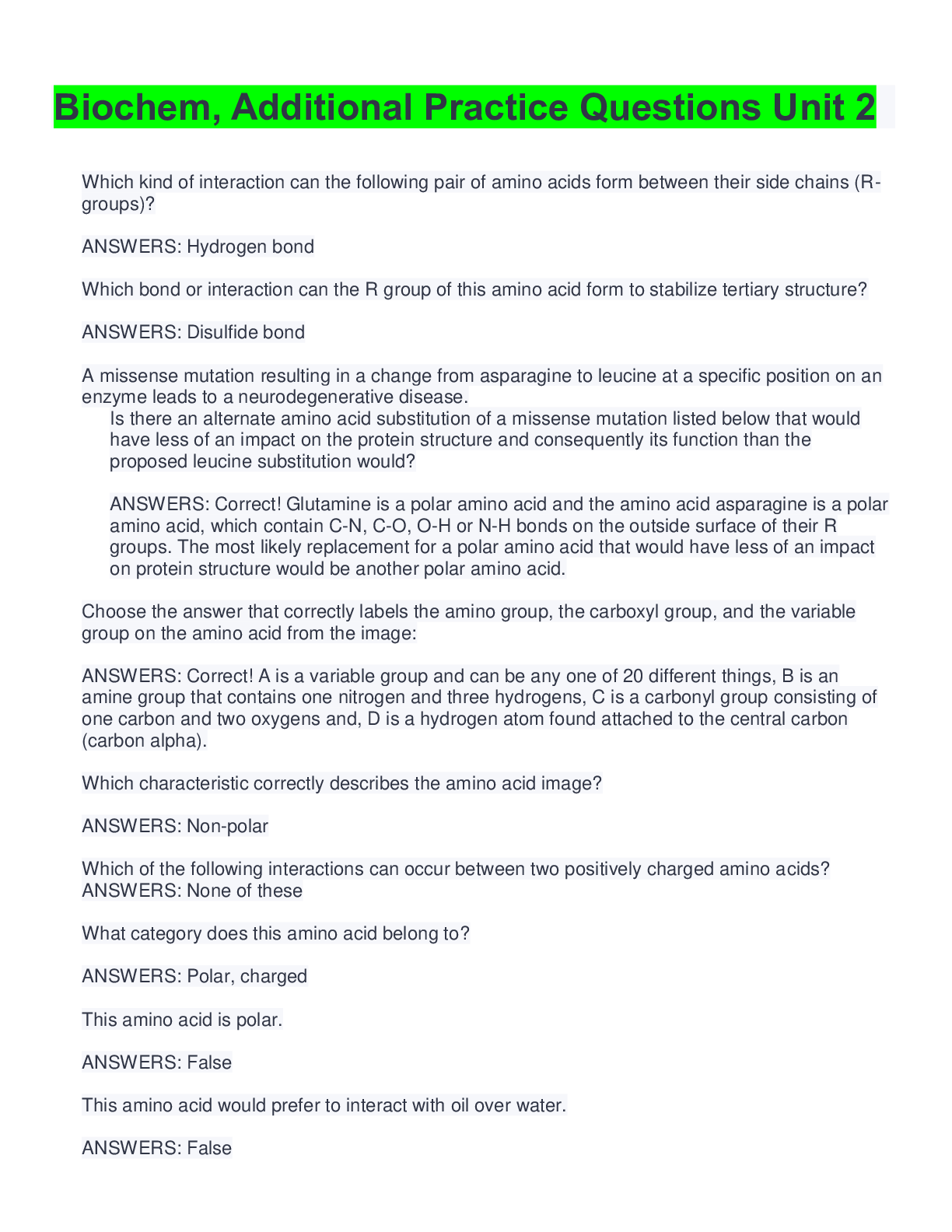*NURSING > Quiz > ATI-TEAS Practice Tests Questions & Answers- all correct with full rationales 2022/2023. (All)
ATI-TEAS Practice Tests Questions & Answers- all correct with full rationales 2022/2023.
Document Content and Description Below
ATI-TEAS Practice Tests Questions & Answers- all correct with full rationales 2022/2023. What is the name of the structure that prevents food from entering the airway? a) trachea b) esophagus ... c) diagram d) epiglottis "the epiglottis covers the trachea during swallowing, thus preventing food from entering the airway" ?= aka the windpipe - is a cylindrical portion of the respiratory tract that joins the larynx with the lungs ?= connects the throat to the stomach - when someone swallows, this contracts to force the food down into the stomach - like other structures in the respiratory system, this structure secretes mucus for lubrication Which substance makes up the pads that provide support between the vertebrae? a) bone b) cartilage c) tendon d) fat Where is the parathyroid gland located? a) neck b) back c) side d) brain Which element w/in the respiratory system is responsible for removing foreign matter from the lungs? a) bronchial tubes b) cilia c) trachea d) alveoli Which of the following comes next? a) molecules b) atoms c) cells d) muscle after cells comes molecules & then atoms On average, how many neutrons does one atom of bromine (Br) have? NOTE: - atomic #= 35 - atomic mass= 79.9 a) 35 b) 44.90 c) 45 d) 79.90 (Test 1) - b) 44.90 to determine the number of neutrons (n), subtract the atomic number (35) from the atomic mass (79.9) On average, how many protons does one atom of zinc (Zn) have? NOTE: a) 30 b) 35 c) 35.39 d) 65.39 What is the name of the process in the lungs by which oxygen is transported from the air to the blood? a) osmosis b) diffusion c) dissipation d) reverse osmosis Which gland is responsible for the regulation of calcium levels? a) parathyroid glands b) thyroid glands c) adrenal glands d) pancreas Which secretion of the digestive system is responsible for water reabsorption? a) large intestine b) duodenum c) small intestine d) gallbladder Which of the following describes one responsibility of the integumentary system? a) distributing vital substances (such as nutrients) throughout the body b) blocking pathogens that cause diseases c) sending leaked fluids from the cardiovascular system back to the blood vessels d) storing bodily hormones that influence gender traits When are the parasympathetic nerves active w/in the nervous system? When an individual.... a) experiences a strong emotion, such as fear or excitement b) feels pain or heat c) is either talking or walking d) is either resting or eating When are the sympathetic nerves active w/in the nervous system? When an individual.... a) experiences a strong emotion, such as fear or excitement b) feels pain or heat c) is either talking or walking d) is either resting or eating When are the sensory neurons active w/in the nervous system? When an individual.... a) experiences a strong emotion, such as fear or excitement b) feels pain or heat c) is either talking or walking d) is either resting or eating When are the sensory-somatic ns active w/in the nervous system? When an individual.... a) experiences a strong emotion, such as fear or excitement b) feels pain or heat c) is either talking or walking d) is either resting or eating Which of the following best describes the relationship b/w the circulation system & the integumentary system a) removal of excess heat from body b) hormonal influence on bp c) regulation of blood's pressure and volume d) development of blood cells w/in marrow The hormonal influence on bp is the result of the relationship between the circulatory system & the ? Once blood has been oxygenated, it travels through the pulmonary veins, through the left atrium, and then through the ? before entering the left ventricle a) tricuspid valve b) mitral valve c) pulmonary arteries d) aorta The part of the human excretory system most responsible for maintaining normal body temperature is the: a) kidney b) bladder c) liver d) sweat glands A part of which body system controls fluid loss, protects deep tissues, and synthesizes vitamin D? a) skeletal system b) muscular system c) lymphatic system d) integumentary system There are three insects that are being compared under a microscope.... Which unit of measurement would be best for this situation? a) centimeters b) meters c) micrometers d) kilometers The respiratory system ? oxygen and ? carbon dioxide a) inhales; exhales b) delivers; expels c) creates; absorbs d) exhales; inhales What is the name for any substance that stimulates the production of antibodies a) collagen b) hemoglobin c) lymph d) antigen The name for a substance that stimulates the production of antibodies is an antigen. An antigen is any substance perceived by the immune system as dangerous. When the body senses an antigen, it produces an antibody Which group of major parts and organs make up the immune system? a) lymphatic system, spleen, tonsils, thymus, & bone marrow b) brain, spinal cord, & nerve cells c) heart, veins, arteries, & capillaries d) nose, trachea, bronchial tubes, lungs, alveolus, & diaphragm Which of the following cannot exist in RNA? a) uracil b) thymine c) cytosine d) guanine In which of the following muscle types are the filaments arranged in a disorderly manner? a) cardiac b) smooth c) skeletal d) rough smooth muscle tissue is said to be arranged in a disorderly fashion b/c it is NOT STRIATED like the other 2 types of muscle (cardiac and skeletal) Rough muscle does not exist (1) Identify the tissue(s) that is/are striated (2) Identify the tissue(s) that is/are NOT striated a) cardiac b) smooth c) skeletal d) rough (2) Not Striated Which hormone is produced by the pineal gland? a) insulin b) testosterone c) melatonin d) epinephrin In the development of genetic traits, one gene must match to one ? for the traits to develop correctly a) codon b) protein c) amino acid d) chromosome Which of the following is not composed of skeletal muscle a) quadriceps b) uterus c) triceps d) gastrocnemius Which of the following best describes the careful ordering of molecules w/in solids that have a fixed shape? a) physical bonding b) polar molecules c) metalloid structure d) crystalline order Which of the following structures move downward during inspiration? a) lungs b) diaphragm c) ribs d) heart Which of the following describes the transport network that is responsible for the transference of proteins throughout the cell? a) golgi apparatus b) endoplasmic reticulum c) mitochondria d) nucleolus Which of the following statements is correct about normal human lung anatomy? R= right; L= left a) the R lung has 3 lobes; the L lung has 2 lobes b) the R lung has 2 lobes; the L lung has 3 lobes c) both lungs have 2 lobes d) both lungs have 3 lobes All of the following belong together except: a) ventricle b) alveoli c) atrium d) septum Which system's primary function is to release hormones? a) cardiovascular b) endocrine c) integumentary d) immune The endocrine system is made up of the pituitary gland, thyroid gland, parathyroid glands, adrenal glands, pancreas, ovaries, and testicles. They secrete hormones that help regulate mood, growth and development, tissue function, metabolism, and sexual function and reproductive processes The heart is located in which of the following areas? a) pelvic b) abdominopelvic c) abdominal d) thoracic Which of the following choices best describes the location of the trachea in relation to the esophagus? a) lateral b) anterior c) posterior d) dorsal A triple beam balance would show the units of measurement in which form? a) liters b) grams c) meters d) gallons A triple beam balance measures the weight of an object Which of the following best describes one of the roles of RNA? a) manufacturing the proteins needed for DNA b) creating the bonds b/w the elements that compose DNA c) sending messages about the correct sequence of proteins in DNA d) forming the identifiable "double helix" shape of DNA Which of the following do CATALYSTS alter to control the rate of a chemical reaction a) substrate energy b) activation energy c) inhibitor energy d) promoter energy How many layers of skin do humans have? a) 1 b) 2 c) 3 d) 4 Which item in the following list is NOT one of the major types of bones in the human body? a) dense bone b) long bone c) short bone d) irregular bone Which of the following bone types is embedded in tendons? a) long bones b) sesamoid bones c) flat bones d) verticle bones Which of the following is not a product of respiration? a) carbon dioxide b) water c) glucose d) ATP Of the following, the blood vessel containing the least-oxygenated blood is: a) the aorta b) the vena cava c) the pulmonary artery d) the capillaries Which layer of the heart contains striated muscle fibers for contraction of the heart? a) pericardium b) epicardium c) endocardium d) myocardium Which blood vessel carries oxygenated blood back to the heart? a) pulmonary vein b) pulmonary artery c) aorta d) superior vena cava How is meiosis similar to mitosis? a) both produce daughter cells that are genetically identical b) both produce daughter cells that are genetically different c) both occur in humans, other animals, and plants d) both occur asexually How do DNA and RNA function together as part of the human genome? a) DNA carries genetic info from RNA to the cell cytoplasm b) RNA carries genetic info from DNA to the cell cytoplasm c) DNA and RNA carry genetic info from the cell nucleus to the cytoplasm d) DNA and RNA do not interact w/in the cell The majority of nutrient absorption occurs in the: a) mouth b) stomach c) small intestine d) large intestine Which of the following characteristics is part of a person's genotype: a) brown eyes that appear hazel in the sunlight b) CFTR genes that cause cystic fibrosis c) black hair that grows rapidly d) being a fast runner Among the choices, the CFTR gene refers to genetic makeup while the other choices describe traits that are observable Where is the interstitial fluid found? a) in the blood an in the lymphatic vessels b) in the tissues around cells c) in the cells d) in the ventricles of the brain Which type of cell secretes antibodies? a) bacterial cell b) viral cell c) lymph cell d) plasma cell What type of molecules are enzymes? a) water molecules b) protein molecules c) tripolar molecules d) inorganic molecules Which structure controls the hormones secreted by the pituitary gland? a) hypothalamus b) adrenal gland c) testes d) pancreas Where does gas exchange occur in the human body? a) alveoli b) bronchi c) larynx d) pharyn All of the following belong together except: a) trachea b) bronchi c) esophagus d) larynx An atom has 5 protons, 5 neutrons, and 6 electrons. What is the electric charge of this atom? a) neutral b) positive c) negative d) undetermined Which of the following best describes the structures found underneath each rib in descending order? a) vein, nerve, artery b) artery, vein, nerve c) vein, artery, nerve d) nerve, vein, artery Which of the following is true regarding the primary function of the spleen? a) it produces bile to emulsify fats b) it filters microorganisms and other foreign substances from the blood c) it helps control blood glucose levels and regulates bp d) it regulates blood clotting factors Which of the following is a protein that interferes with virus protection? a) lysozyme b) prion c) interferon d) keratin Which of the following does not contain blood vessels? a) hyperdermis b) hypodermis c) dermis d) epidermis What structure releases hormones that stimulate the gonads during puberty? a) hypothalamus b) midbrain c) basal ganglia d) hippocampus Which of the following structures has the lowest blood pressure? a) arteries b) arteriole c) venule d) vein Which of the heart chambers is the most muscular? a) left atrium b) right atrium c) left ventricle d) right ventricle Which part of the brain interprets sensory information? a) cerebrum b) hindbrain c) cerebellum d) medulla oblongata Which part of the brain controls voluntary and involuntary movements? a) cerebrum b) hindbrain c) cerebellum d) medulla oblongata Which part of the brain is responsible for blood flow and breathing (among other things as well) a) cerebrum b) hindbrain c) cerebellum d) medulla oblongata A vaccination is a way of acquiring which type of immunity? a) passive natural immunity b) active natural immunity c) active artificial immunity d) passive artificial immunity Which component of the nervous system is responsible for lowering the heart rate? a) central NS b) sympathetic NS c) parasympathetic NS d) distal NS Which component of the nervous system is responsible for accelerating the heart rate? a) central NS b) sympathetic NS c) parasympathetic NS d) distal NS Which of the following is NOT classified as a synovial joint? a) femur and pelvis b) skull bone c) humerus and ulna d) humerus and scapula A defect in which of the following parts of bone would be most likely to result in stunted growth? a) diaphysis b) epiphysis c) epiphyseal plate d) periosteum An overactivation of which of the following bone cells could lead to osteoperosis? a) osteon b) osteoblast c) osteoclast d) osteocyte Drugs designed to treat osteoporosis would most likely increase the activity of which of the following bone cells? a) osteoblast b) osteoclast c) osteocyte d) osteon Which of the following bones can be characterized as a long bone? a) carpal b) humerus c) pelvis d) vertebra The autonomic nervous system would be involved in all of the following EXCEPT a) digesting a meal b) exhaling after holding your breath c) maintaining blood pressure d) jerking away from a painful stimulus Re: D- reacting to a painful stimulus is a reflex action under involuntary control. However, reflex actions are controlled by skeletal muscles Which of the following neuromuscular processes are involved in chemical digestion? a) autonomic control by the sciatic nerve b) somatic control by the vagus nerve c) smooth muscle contraction in the small intestine d) skeletal muscle contraction in the stomach (Kaplan p212) Muscular contraction will only occur if a) acetylcholine is released by the dendrite b) an action potential travels down the axon c) all the motor units are activated d) the muscle tissue is polarized (Kaplan p214) Signals from touch receptors in the hand are transmitted to the brain via a) an afferent neuron b) the brain stem c) an efferent neuron d) a motor neuron (Kaplan p215) Damage to the cerebellum would most likely result in a) speech impairment b) difficulty walking c) loss of short-term memory d) life-threatening injury (Kaplan p215) Which of these statements is correct regarding muscle contraction? a) when a person is at rest, no muscles are contracting b) muscle contraction is activated by actin and myelin cross-bridges c) sensory neurons stimulate muscle tissue to contract d) muscle fibers contract in an all-or-none fashion (Kaplan p215) Which of the following blood component levels would be expected to increase in response to a viral infection? a) erythrocytes b) leukocytes c) plasma d) platelets (Kaplan p217) Which of the following statements regarding the pulmonary arteries is correct? They carry..... a) oxygenated blood away from the heart b) oxygenated blood away from the lungs c) deoxygenated blood to the heart d) deoxygenated blood to the lungs (Kaplan p219) Which of the following valves prevents blood from backflowing b/w the right atrium & right ventricle a) aortic b) bicuspid c) mitral d) tricuspid (Kaplan p221) Which of the following correctly describes the flow of blood through the double loop system? a) L ventricle - R ventricle - capillaries - pulmonary vein - R atrium b) L ventricle - pulmonary vein - lungs - pulmonary artery - R ventricle c) L ventricle - aorta - capillaries - vena cava - R ventricle d) L ventricle - arteries - veins - R ventricle - R atrium Which of the following blood particles are responsible for blood clotting? a) platelets b) antibodies c) hemoglobin d) lymph (Kaplan p221) Which of the following correctly describes the pathway of air into the lungs? a) larynx- pharynx - trachea - bronchi - alveoli b) pharynx - larynx - trachea - bronchi - alveoli c) trachea - pharynx - larynx - bronchi - alveoli d) pharynx - larynx - bronchi - trachea - alveoli (Kaplan p223) Which of the following would NOT be expected to cause a decrease in ventilation rate? a) inc in blood oxygen concentration b) dec in blood carbon dioxide concentration c) inc in blood pH d) dec in blood pH (Kaplan p224) Which of the following lung volumes is responsible for preventing lung collapse? a) tidal volume b) residual volume c) vital capacity d) total lung capacity (Kaplan p227) Which of the following would lead to an increase in ventilation rate? a) the concentration of oxygen in the blood is decreased b) the pH of the blood is increased c) the pH of the blood is decreased d) the concentration of carbon dioxide in the blood is decreases (Kaplan p227) Which of the following lung ailments is caused by a mycobacterium infection? a) influenza b) pneumonia c) tuberculosis d) asthma (Kaplan p227) Which of the following lung ailments is caused by a coronavirus? a) influenza b) pneumonia c) tuberculosis d) asthma (Kaplan p227) Which of the following lung ailments is caused by a infection by mycoplasma bacteria? a) influenza b) pneumonia c) tuberculosis d) asthma (Kaplan p227) Which of the following organs is part of the alimentary canal? a) trachea b) pharynx c) larynx d) salivary glands (Kaplan p229) Which of the following macromolecule groups is chemically digested for the first time in the stomach? a) carbohydrates b) proteins c) lipids d) nucleic acids Which of the following describes the region of the kidney where blood is filtered? a) tubule b) pelvis c) corpuscle d) medulla (Kaplan p236) Which of the following hormones would directly cause urine to become more concentrated? a) epinephrine b) renin c) aldosterone d) ADH (Kaplan p237) Which of the following is absorbed in the colon? a) vit B6 b) vit C c) vit D d) vit K (Kaplan p233) After passing through the pyloric sphincter, a food high in protein would be in which of the following states? a) acidic and partially digested b) acidic and completely digested c) alkaline and partially digested d) alkaline and completely digested (Kaplan p233) Which of the following hormones signals satiety? a) gastrin b) ghrelin c) leptin d) secretin (Kaplan p233) After passing through the collecting duct, urine flows into which of the following genitourinary structures? a) bladder b) nephron c) ureter d) urethra (Kaplan p238) Which of the following vessels directs blood into the glomerulus a) afferent arteriole b) bowman's capsule c) efferent arteriole d) renal artery (Kaplan p238) Blood leaves the heart and travels to the kidneys through the ? a) afferent arteriole b) bowman's capsule c) efferent arteriole d) renal artery (Kaplan p238) Which of the following hormones increase sodium reabsorption in the renal tubule? a) adrenal and renin b) aldosterone and epinephrine c) angiotensin and aldosterone d) renin and ADH (Kaplan p238 Which of the following hormones would be secreted following a drop in blood calcium levels a) epinephrine b) calcitonin c) parathyroid hormone d) insulin (Kaplan p240) [Show More]
Last updated: 1 year ago
Preview 1 out of 31 pages
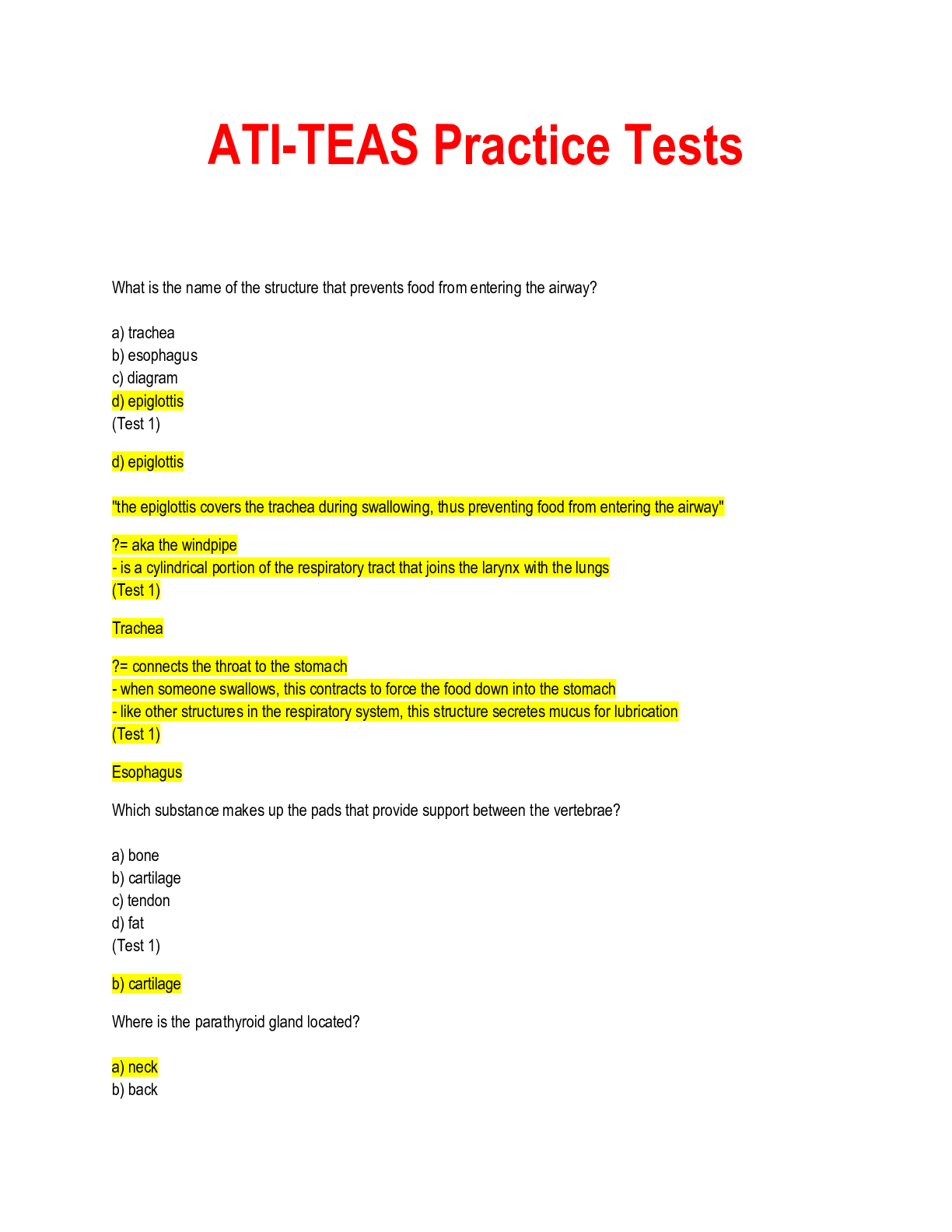
Reviews( 0 )
Document information
Connected school, study & course
About the document
Uploaded On
Oct 19, 2022
Number of pages
31
Written in
Additional information
This document has been written for:
Uploaded
Oct 19, 2022
Downloads
0
Views
60

